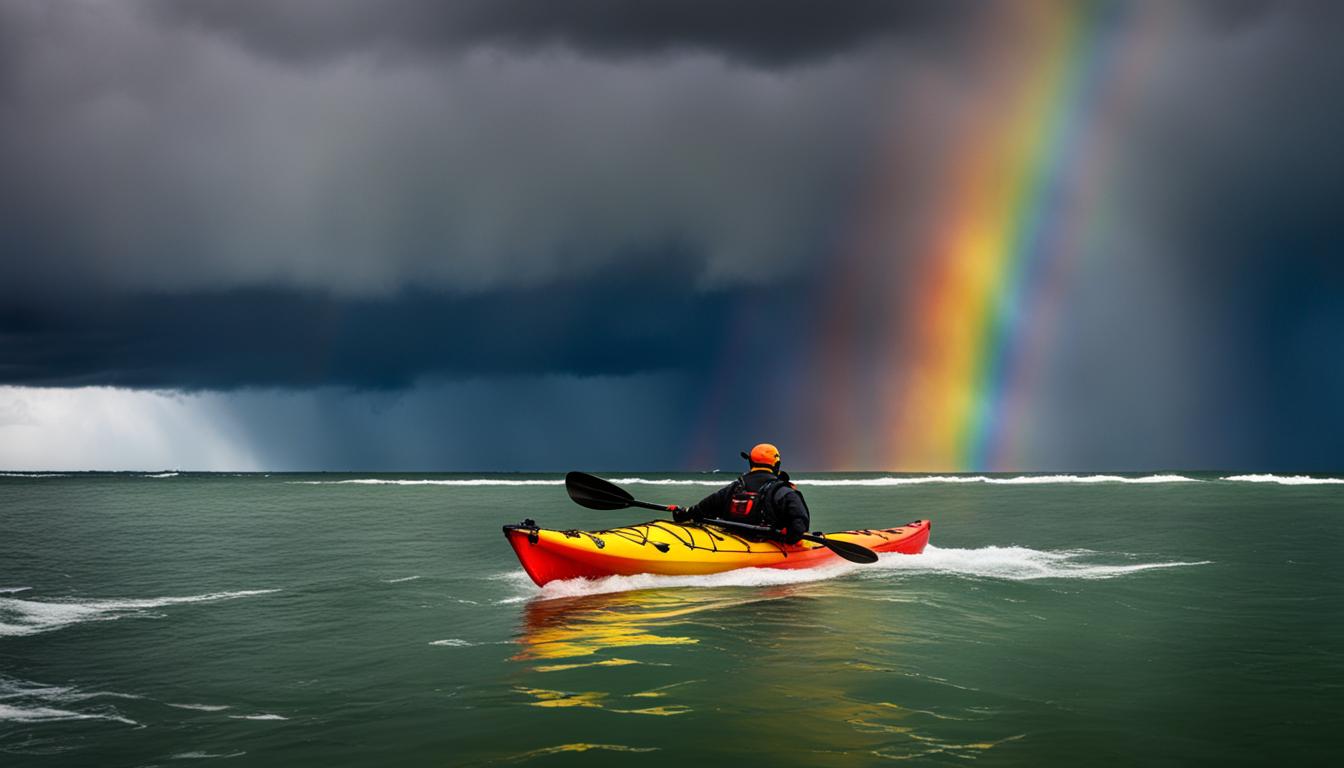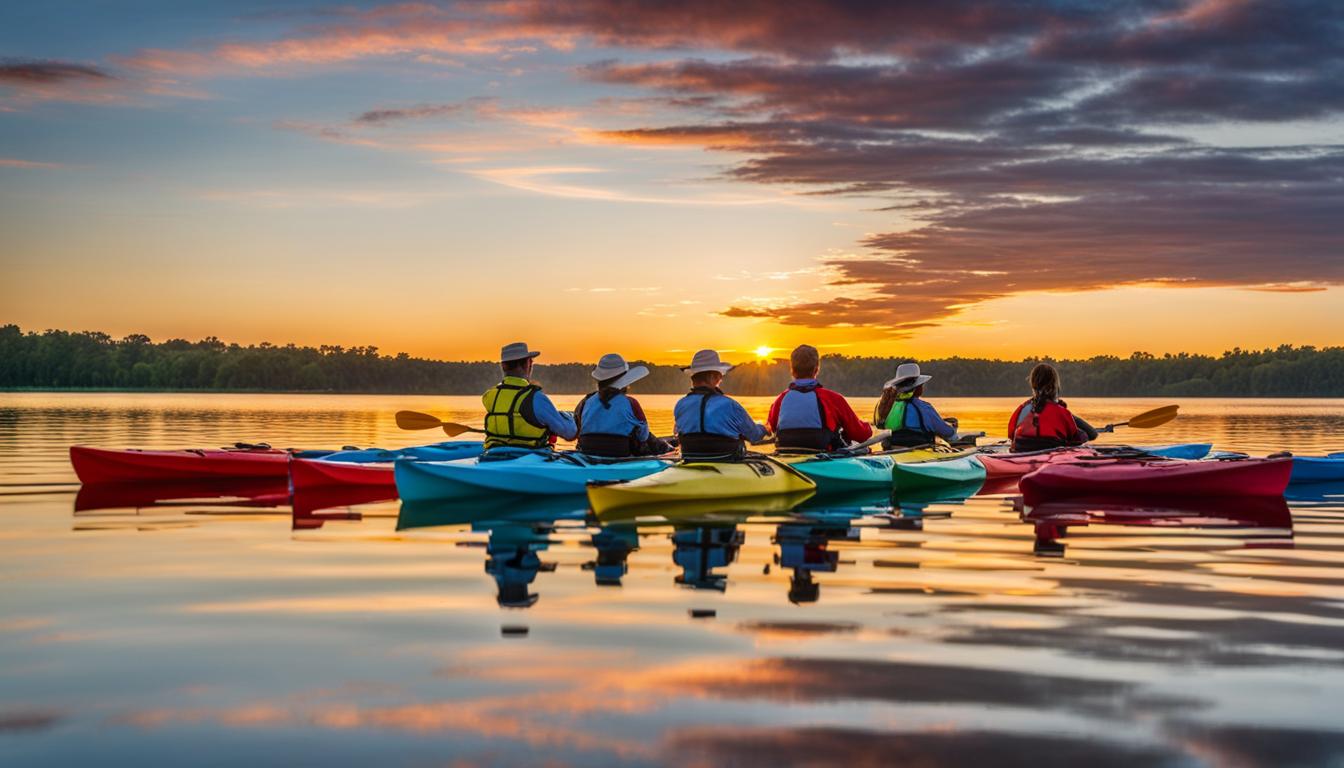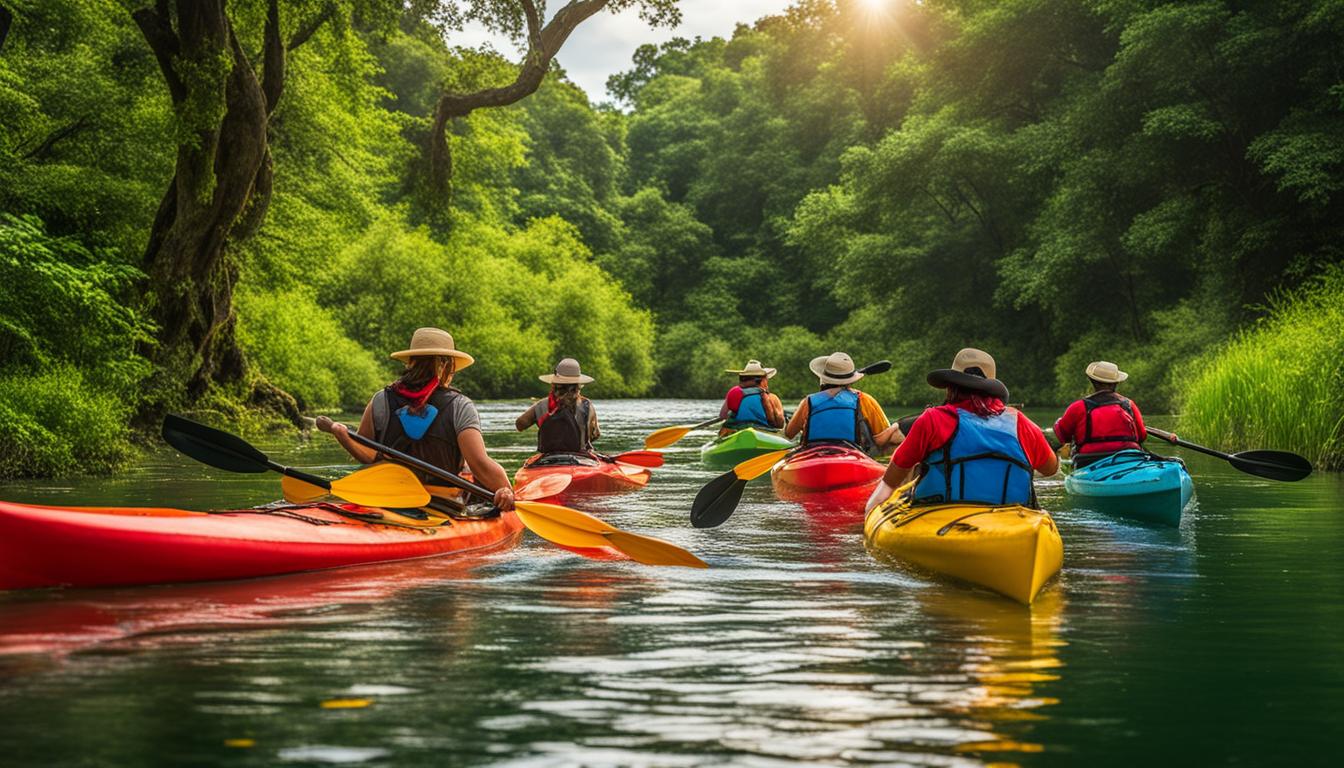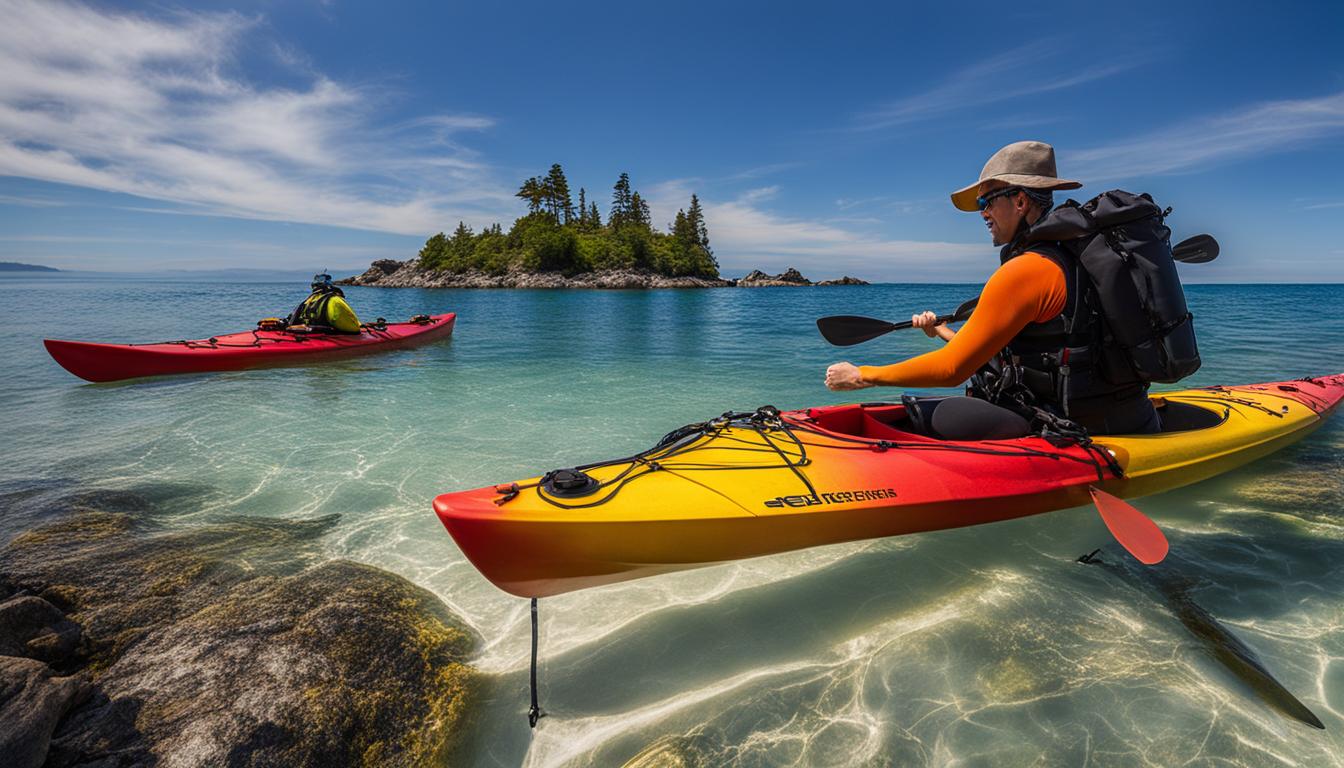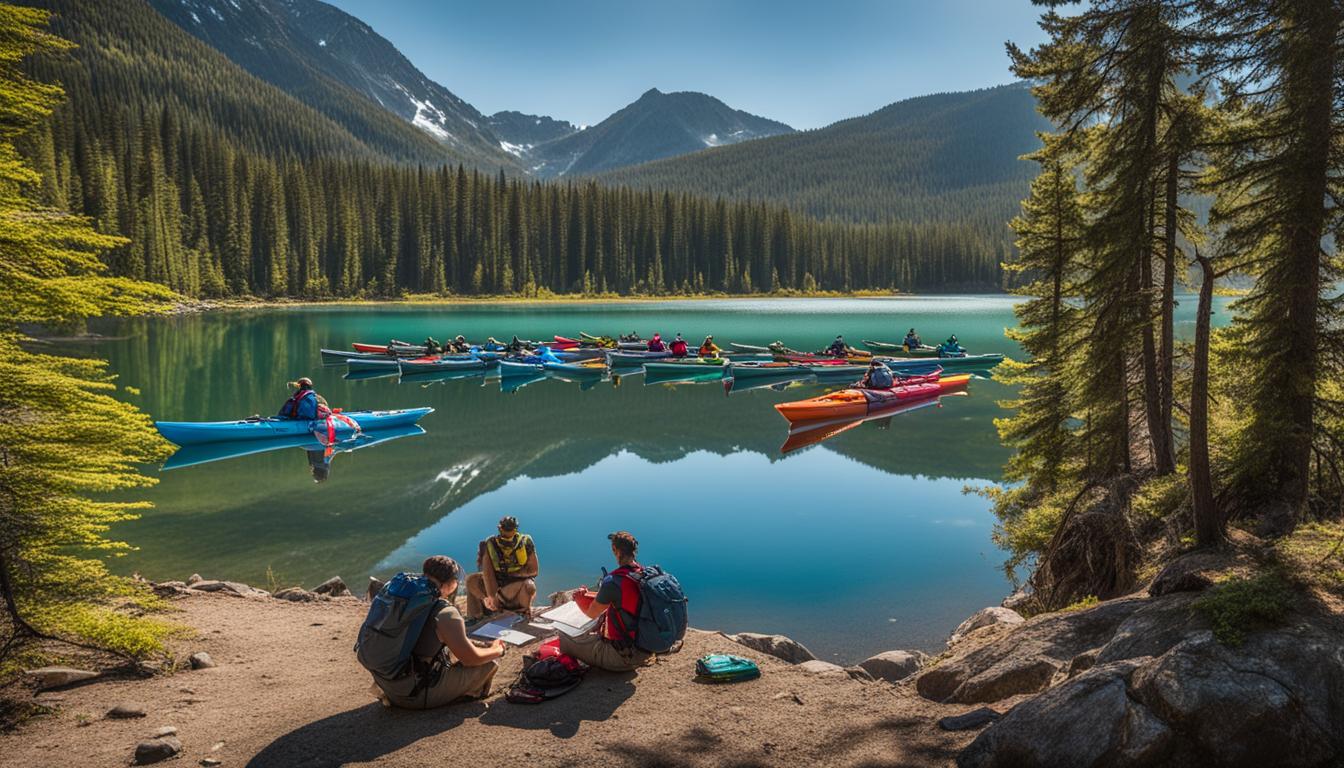Kayak camping offers a unique and adventurous way to connect with nature and explore remote locations. However, unpredictable weather conditions can pose challenges and require careful planning. Whether you’re camping in the rain, managing heat in hot climates, or braving cold weather, being prepared is key to ensuring a safe and enjoyable experience.
In this comprehensive guide, we will provide you with valuable tips and advice on how to navigate through diverse weather situations while kayak camping. From selecting the right gear to dressing appropriately and planning for safety, we’ve got you covered.
Key Takeaways:
- Choose a sea kayak designed for saltwater and pack essential safety equipment.
- Dress appropriately for the weather, whether it’s hot, cold, or wet.
- Plan your route carefully, check weather forecasts, and carry essential safety items.
- Stay vigilant and adapt to weather changes while kayaking.
- Pack essential items such as a tent, sleeping bag, stove, water, and food for your trip.
Choosing the Right Gear for Weather Kayak Camping
When it comes to weather kayak camping, having the right gear is essential. Proper equipment can make all the difference in ensuring a safe and enjoyable experience. Here are some key items to consider:
Sea Kayak
Start with a sea kayak designed for saltwater conditions. These kayaks are more stable and can handle rough waters. They also offer more storage space for your gear.
Safe Route Plan
Before setting off on your kayak camping adventure, make sure you have a safe route plan. Familiarize yourself with the area and choose routes that are suitable for the weather conditions you’ll be facing.
Essential Safety Equipment
Carry essential safety equipment, including a life jacket, bilge pump, and whistle. These items are crucial in case of an emergency and can help ensure your safety while out on the water.
Dry Bags
Use dry bags to protect your belongings from water damage. Pack your gear and clothing inside these waterproof bags to keep them dry even if your kayak capsizes or gets wet.
| Essential Gear for Weather Kayak Camping | |
|---|---|
| Sea Kayak | A kayak designed for saltwater conditions |
| Safe Route Plan | A detailed plan of your intended route |
| Essential Safety Equipment | Life jacket, bilge pump, and whistle |
| Dry Bags | Waterproof bags to protect your belongings |
By choosing the right gear, you can ensure that you’re well-prepared for diverse weather conditions while kayak camping. Remember to always check the weather forecast before heading out and adjust your plans accordingly. With the right equipment and preparation, you can have a safe and enjoyable kayak camping experience.
Having the right gear can make all the difference in ensuring a safe and enjoyable experience while weather kayak camping.
Dressing Appropriately for Weather Kayak Camping
Kayak camping in different weather conditions requires dressing appropriately to ensure your comfort and safety. The right clothing and gear can help you manage heat, stay warm in cold weather, and stay dry in wet conditions.
Managing Heat While Kayak Camping
In hot weather, it’s important to wear clothing that allows your skin to breathe and keeps you cool. Opt for swimwear or lightweight clothing that is moisture-wicking and quick-drying. A rashguard or a moisture-wicking t-shirt can provide protection from the sun and help keep you cool. Don’t forget to wear a sun-shielding hat and apply sunscreen to protect your skin from harmful UV rays. Neoprene footwear is also recommended to protect your feet from hot surfaces.
Kayak Camping in Cold Weather
When kayak camping in cold weather, it’s crucial to dress in layers to stay warm. Start with a thermal base layer to provide insulation and moisture-wicking properties. Layer up with mid-layers such as fleece or wool to trap heat and provide additional warmth. Wear a drysuit or a wetsuit to keep your body dry and protected from the elements. Neoprene socks will keep your feet warm, while pogies will provide hand protection and help maintain dexterity. Don’t forget to wear a wool or synthetic cap to keep your head warm.
Staying Dry in Wet Weather Kayak Camping
When camping in wet weather, it’s important to have proper rain gear to keep you dry. A waterproof spray jacket and pants will protect you from rain and splashes. Make sure the jacket has a hood to shield your head from rain. It’s also a good idea to wear quick-drying clothing and avoid cotton, which takes a long time to dry. Neoprene booties or waterproof shoes will keep your feet dry and comfortable. Consider using a spray skirt to keep the spray off your lower body, especially in windy and wet conditions.
By dressing appropriately for weather kayak camping, you can ensure your comfort and safety while enjoying your outdoor adventure. Remember to check the weather forecast before your trip and adjust your clothing accordingly. Stay prepared and have a great time exploring the wonders of nature!
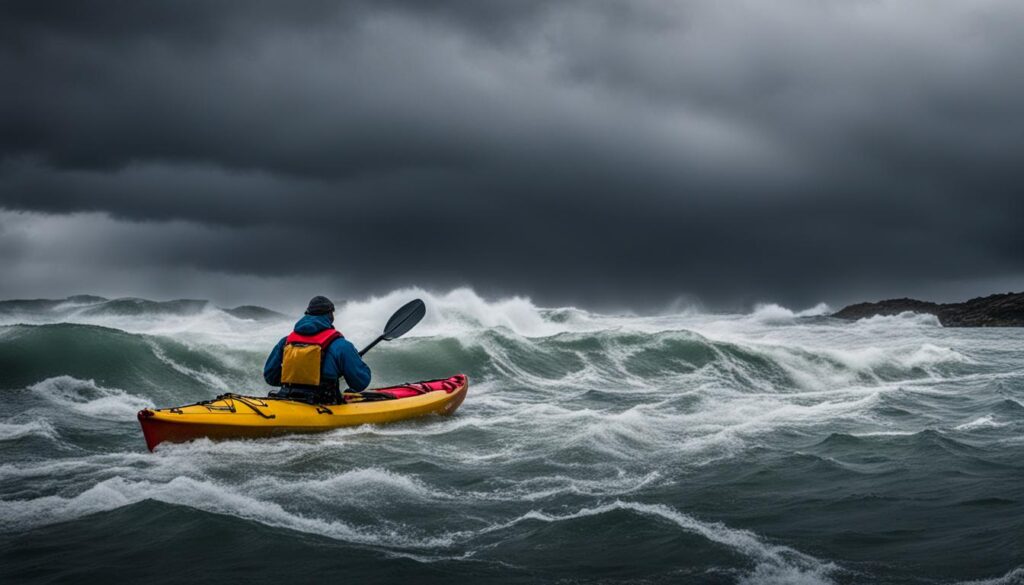
Planning and Safety Considerations for Weather Kayak Camping
When it comes to weather kayak camping, planning and safety should be your top priorities. Being well-prepared and informed can make all the difference in ensuring a safe and enjoyable experience on the water.
Checking Weather Forecasts and Conditions
Before heading out on your kayak camping trip, always check the weather forecasts and conditions for the area you’ll be paddling in. Pay attention to wind speed, wave height, and any potential storms or weather changes that may arise. It’s important to have a good understanding of what to expect so you can plan your route accordingly.
Adapting to Weather Changes
Weather conditions can change rapidly while kayaking, so it’s crucial to be prepared to adapt. Keep a close eye on the sky and the water, and be ready to make necessary adjustments to your route or itinerary. If you notice the wind picking up or dark clouds rolling in, consider paddling closer to shore or finding a safe spot to wait out any inclement weather.
Carrying Safety Equipment
Having the right safety equipment is essential for weather kayak camping. Make sure to carry a paddle float, towline, maps, compass, and a weather/VHF radio. These tools can help you navigate through challenging conditions and ensure that you can call for help if needed. It’s always better to be over-prepared when it comes to safety.
| Safety Equipment Checklist | Essential | Optional |
|---|---|---|
| Life Jacket | X | |
| Bilge Pump | X | |
| Whistle | X | |
| Paddle Float | X | |
| Towline | X | |
| Maps | X | |
| Compass | X | |
| Weather/VHF Radio | X |
By incorporating these planning and safety considerations into your weather kayak camping adventures, you’ll be well-equipped to handle any weather changes that come your way. Remember to always prioritize safety and make informed decisions based on the conditions you encounter. Happy paddling!
Tips for Handling Weather Changes While Kayak Camping
When kayak camping in varied weather conditions, it’s important to be prepared for sudden weather changes. Here are some tips to help you navigate through these changes and ensure a safe and enjoyable experience:
Keep an Eye on the Weather and Water Conditions
Stay updated on the forecast and monitor any changes in weather conditions. Use a reliable weather app or radio to receive real-time updates while you’re out on the water. Additionally, pay attention to the water conditions, such as the wind speed, tide, and any potential storms or heavy rain. This information will help you make informed decisions about whether to continue paddling or seek shelter.
Paddle During Calmer Hours
Try to plan your paddling sessions during the mornings and evenings when the water tends to be calmer. This will make it easier to handle any wind or choppy waves that may arise during your kayak camping trip. By avoiding the peak hours of the day, you can minimize the impact of strong winds and enjoy a smoother paddling experience.
Protect Yourself from the Elements
During windy conditions, it’s crucial to protect yourself from the wind chill and potential water spray. Wear suitable windbreakers, waterproof jackets, and kayaking gloves to shield yourself from the elements. Additionally, consider using a spray skirt to keep the spray off your lower body and maintain warmth. Don’t forget to apply sunscreen and wear a brimmed hat to protect yourself from the sun’s rays, especially if you’ll be paddling for extended periods.
Remember, weather changes can occur unexpectedly, so always be prepared and prioritize your safety while kayak camping in windy conditions. By staying informed, choosing the right gear, and taking necessary precautions, you can navigate through the changing weather and have an amazing kayak camping experience.
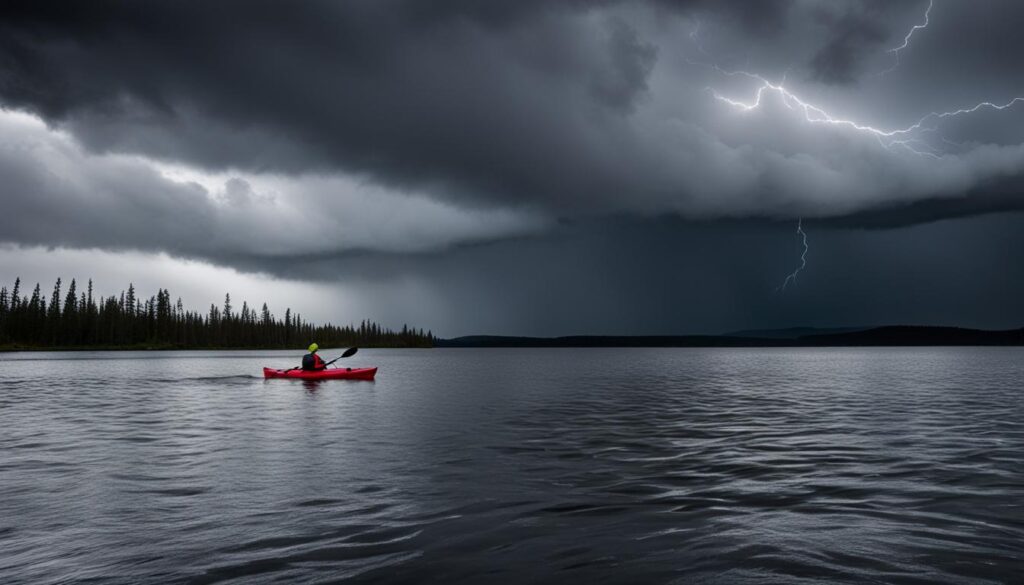
Table: Essential Gear for Handling Weather Changes
| Essential Gear | Description |
|---|---|
| Windbreaker or waterproof jacket | Protects you from wind and water spray |
| Kayaking gloves | Provides grip and warmth |
| Spray skirt | Keeps lower body dry and shields from spray |
| Sunscreen | Protects from harmful UV rays |
| Brimmed hat | Shields face and neck from the sun |
Always refer to the weather forecast, assess the water conditions, and use your judgment to determine whether it’s safe to continue paddling or find shelter. By following these tips and being prepared, you can confidently handle weather changes while kayak camping and make the most of your outdoor adventure.
Essential Items to Pack for Weather Kayak Camping
When embarking on a weather kayak camping trip, packing the right essentials is crucial. Here is a list of must-have items that will ensure you are prepared for diverse weather conditions:
Camping Gear:
- Tent: A waterproof and durable tent to provide shelter.
- Sleeping Bag: Choose one suitable for the expected temperature range.
- Sleeping Mat: Insulating and comfortable for a good night’s sleep.
- Stove and Fuel: A portable cooking system for preparing meals.
- Cookware and Utensils: Lightweight pots, pans, and utensils for cooking.
Food and Water:
- Water: Carry enough water for your trip, considering extra for emergencies.
- Water Purification Tablets: For treating water from natural sources.
- Food: Pack lightweight and non-perishable meals and snacks.
Safety and Navigation:
- Headlamp: Essential for illuminating your surroundings at night.
- Multi-tool: A versatile tool for various tasks.
- Toilet Paper and Trowel: For practicing Leave No Trace principles.
- Satellite Communication Device: Stay connected in remote areas.
- First Aid Kit: Include essential medical supplies and medications.
These items will allow you to be self-sufficient during your weather kayak camping adventure. Remember to pack them in dry bags to protect them from water exposure. Proper weight distribution in your kayak is important for stability and maneuverability on the water. With these essentials, you can confidently explore different weather conditions and have a safe and enjoyable kayak camping experience.
Table: Essential Items for Weather Kayak Camping
| Camping Gear | Food and Water | Safety and Navigation |
|---|---|---|
| Tent | Water | Headlamp |
| Sleeping Bag | Water Purification Tablets | Multi-tool |
| Sleeping Mat | Food | Toilet Paper and Trowel |
| Stove and Fuel | Satellite Communication Device | |
| Cookware and Utensils | First Aid Kit |
Conclusion
Weather kayak camping can be a rewarding and exhilarating experience, allowing you to connect with nature in a unique and unforgettable way. However, to fully enjoy your trip and ensure your safety, it is essential to plan and prepare for the seasonal weather conditions you may encounter.
By following the tips and advice outlined in this guide, you can equip yourself with the necessary knowledge and gear to navigate through diverse weather situations. Whether you’re facing scorching heat, chilly winds, or unexpected rain showers, being prepared will make all the difference.
Remember to stay up-to-date with weather forecasts and be adaptable to changing conditions. Plan your route carefully, dress appropriately, and pack essential items. By prioritizing safety and making informed decisions, you’ll be able to have an incredible kayak camping experience, no matter the season.
FAQ
What gear do I need for weather kayak camping?
To be prepared for varied weather conditions while kayak camping, you’ll need a sea kayak designed for saltwater, a safe route plan, knowledge of what to do in case of a capsize, checking conditions and tide times, packing essential items, using dry bags, considering weight distribution, and carrying safety equipment such as a life jacket, bilge pump, and whistle.
How should I dress for weather kayak camping?
Dressing appropriately is key. In hot weather, wear swimwear or lightweight clothing, a rashguard or moisture-wicking t-shirt, neoprene footwear, a sun-shielding hat, and apply sunscreen. In cold weather, wear a drysuit or wetsuit, thermal base and mid-layers, neoprene socks, pogies for hand protection, and a wool/synthetic cap. It’s also important to have a spray jacket or rain jacket and pants to stay dry in wet weather.
What planning and safety measures should I take for weather kayak camping?
Planning and safety are crucial. Before your trip, plan a safe route, check weather forecasts, and leave a trip plan with someone responsible. Be prepared to adapt to weather changes, avoid large open water crossings and areas with strong winds, and paddle close to shore for safety. Always carry safety equipment such as a paddle float, towline, maps, compass, and a weather/VHF radio.
How can I handle weather changes while kayak camping?
Weather changes can occur while kayak camping, so it’s important to be prepared. Keep an eye on weather and water conditions, paddle in the mornings and evenings when the water is calmer, and avoid paddling in windy conditions. Be ready for weather exposure by applying sunscreen, wearing a brimmed hat, windbreakers, waterproof jackets, and kayaking gloves. Consider using a spray skirt to keep spray off your lower body in windy conditions.
What essential items should I pack for weather kayak camping?
When packing for weather kayak camping, prioritize essential items such as a tent, sleeping bag, sleeping mat, stove and fuel, cookware and utensils, water and food, water purification tablets, headlamp, multi-tool, toilet paper and trowel, sunscreen, spare set of clothes, satellite communication device, and a first aid kit. Use dry bags to keep gear dry, and ensure proper weight distribution in the kayak.

